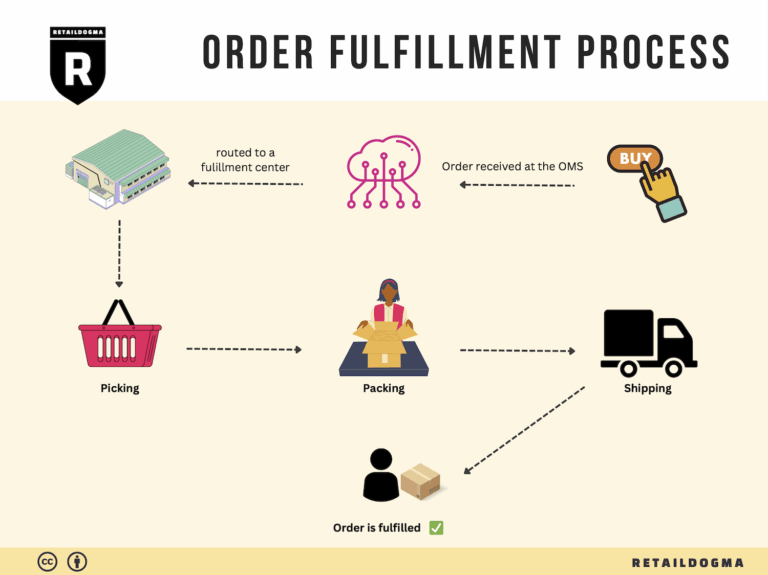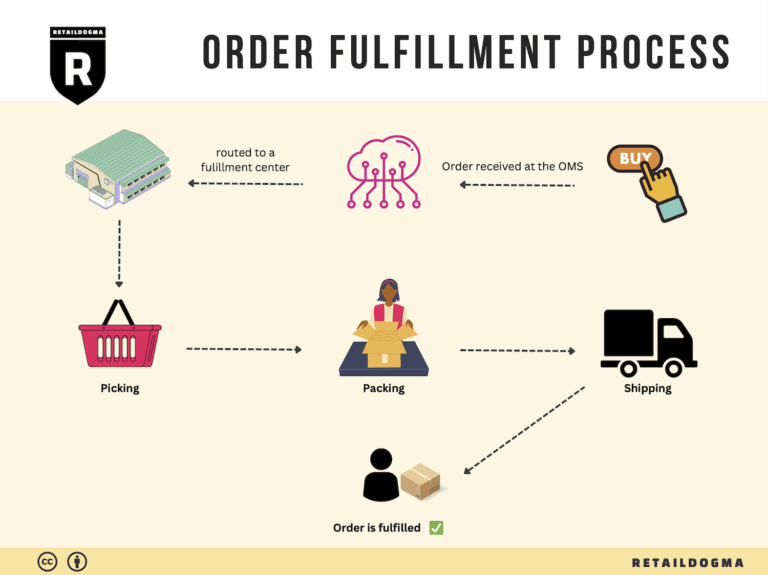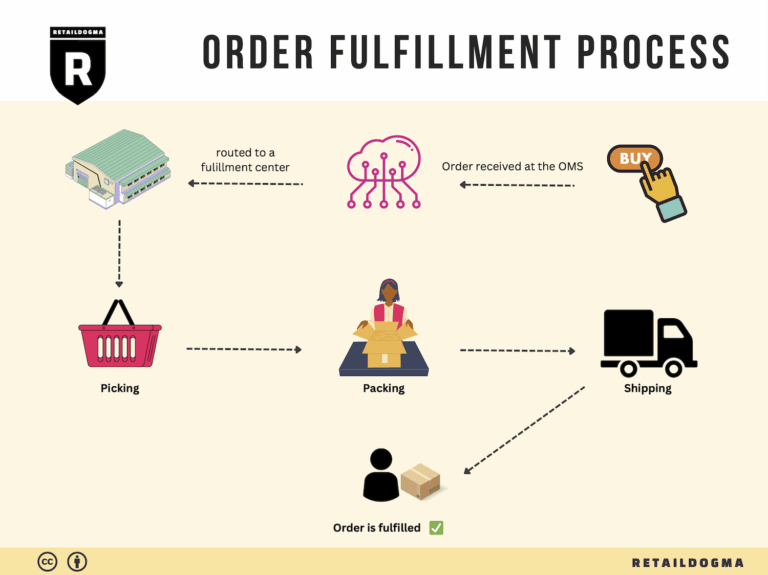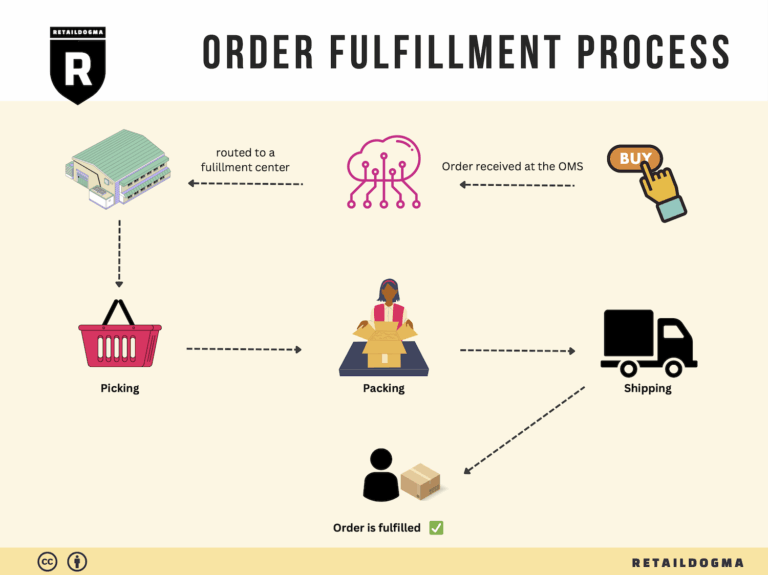How Order Fulfillment Works: A Step-by-Step Guide for Businesses
What is E-commerce Fulfillment? An Introduction for Growing Businesses
Understanding E-commerce Fulfillment
As a growing online business owner, you may often find yourself overwhelmed by the logistics of packing and shipping orders. The excitement of increasing sales can quickly turn into frustration as you navigate the complexities of delivering products to your customers efficiently. This is where e-commerce fulfillment comes into play.
E-commerce fulfillment refers to the entire process of getting a product from your warehouse or fulfillment center to the hands of your customer. It encompasses everything from inventory management, order processing, packing, and shipping, to handling returns. A well-structured fulfillment strategy is crucial for maintaining customer satisfaction and scaling your operations effectively.
In this guide, we will explore the various fulfillment models available to growing businesses, including Third-Party Logistics (3PL) and Fulfillment by Amazon (FBA). Each model has its unique advantages and challenges, and understanding these will help you make informed decisions about which path to take.
We will also delve into the core services that fulfillment partners typically offer. These services include inventory management, order tracking, shipping, and returns handling. Knowing what services are available will enable you to select a partner that aligns with your business needs.
Choosing the right fulfillment partner is a critical decision for your business. We will provide practical tips on what to look for in a partner, including their technology capabilities, experience, scalability, and customer service. A reliable partner can significantly enhance your operational efficiency, allowing you to focus on your core business activities.
Pricing is another essential aspect of fulfillment that we will cover in detail. Understanding the cost structure of different fulfillment models can help you budget effectively and avoid unexpected expenses. We will break down common pricing components, including storage fees, picking and packing fees, and shipping costs.
Ultimately, the goal of this guide is to empower you to make smart, informed decisions about your logistics strategy. By understanding the intricacies of e-commerce fulfillment, you can better navigate the challenges that come with scaling your business and ensure a seamless delivery experience for your customers. Whether you are just starting or looking to optimize your existing processes, this guide will serve as a valuable resource in your journey toward e-commerce success.
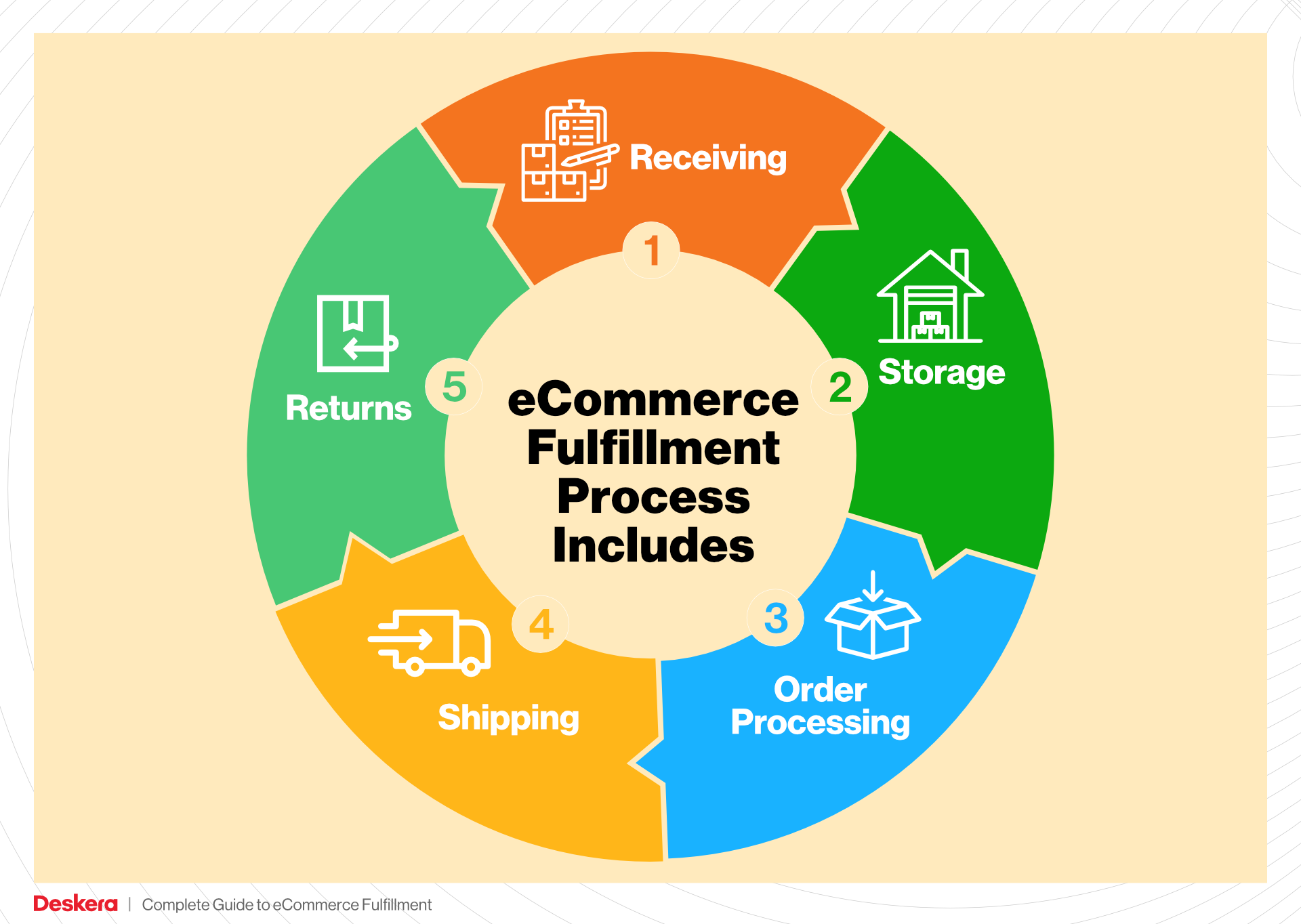
What You’ll Learn In This Guide
- What is E-commerce Fulfillment? An Introduction for Growing Businesses
- The Order Fulfillment Process: From ‘Buy’ Button to Customer’s Door
- Comparing Fulfillment Models: In-House vs. 3PL vs. Dropshipping
- A Deep Dive into Amazon FBA: Pros, Cons, and Who It’s For
- Core Services Offered by Fulfillment Centers
- How to Choose a Fulfillment Partner: A 6-Point Checklist
- Understanding Fulfillment Pricing: A Breakdown of Common Fees
- Frequently Asked Questions (FAQs) about Fulfillment
- Conclusion: Is Outsourcing Fulfillment the Right Move for Your Business?
- Important Disclaimer
The Order Fulfillment Process: From ‘Buy’ Button to Customer’s Door
1. Receiving Inventory
The order fulfillment process begins with receiving inventory, a critical step that ensures the right products are available for order processing. When goods arrive at the micro-fulfillment center (MFC), they are checked against the purchase orders to verify accuracy. This involves inspecting for any damage, confirming quantities, and ensuring the correct items have been delivered.
Importance: Proper receiving is essential for maintaining inventory accuracy and preventing stock discrepancies. Errors at this stage can lead to significant issues down the line, including delays in order fulfillment and customer dissatisfaction.
Key Term: SKU (Stock Keeping Unit) – A unique identifier assigned to each product to help track inventory levels and manage stock efficiently.
2. Warehouse Storage
Once the inventory is received, it is stored in the warehouse in a systematic manner. Products are organized based on various factors such as size, type, or demand frequency. Micro-fulfillment centers often utilize automated storage systems that leverage robotics to maximize space and improve retrieval times.
Importance: Efficient storage solutions are vital for optimizing space and ensuring quick access to products. This not only speeds up the order fulfillment process but also minimizes the risk of errors during order picking.
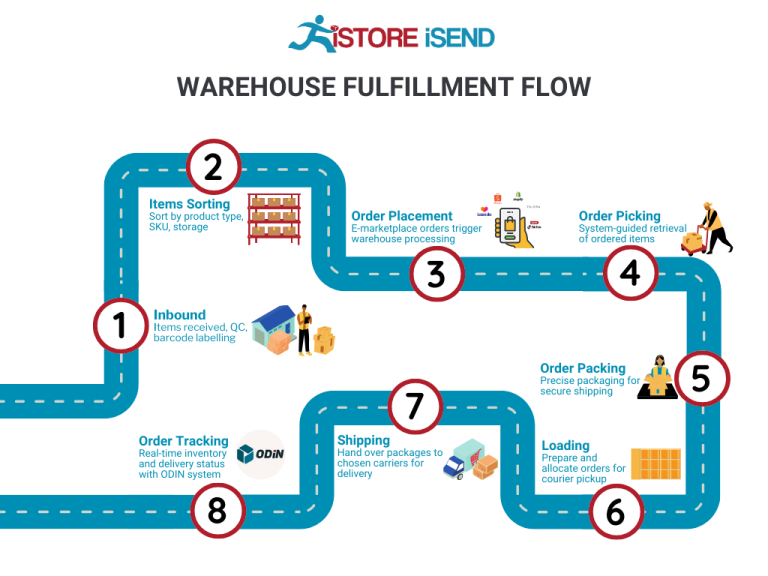
Key Term: ABC Analysis – A method used to categorize inventory into three classes (A, B, and C) based on their importance or value, helping prioritize storage and management efforts.
3. Order Picking
The next step is order picking, where staff or automated systems retrieve the items needed to fulfill customer orders. In a micro-fulfillment center, this process can be enhanced through the use of pick lists—documents that outline the items to be gathered for each order. Advanced systems may employ robotics to assist in this stage, increasing efficiency and accuracy.
Importance: Order picking is one of the most labor-intensive aspects of fulfillment. Streamlining this process reduces the time taken to prepare orders, which is crucial for meeting customer expectations, especially in today’s fast-paced e-commerce environment.
Key Term: Pick List – A document or digital display that guides warehouse staff or robots on which items to collect for fulfilling specific orders.
4. Order Packing
After items are picked, they move to the packing stage. Here, products are carefully packed into boxes or containers, ensuring they are secure for transit. This step often involves the use of packing slips, which provide details about the order, including item descriptions and quantities. Some micro-fulfillment centers use automated packing machines to enhance speed and accuracy.
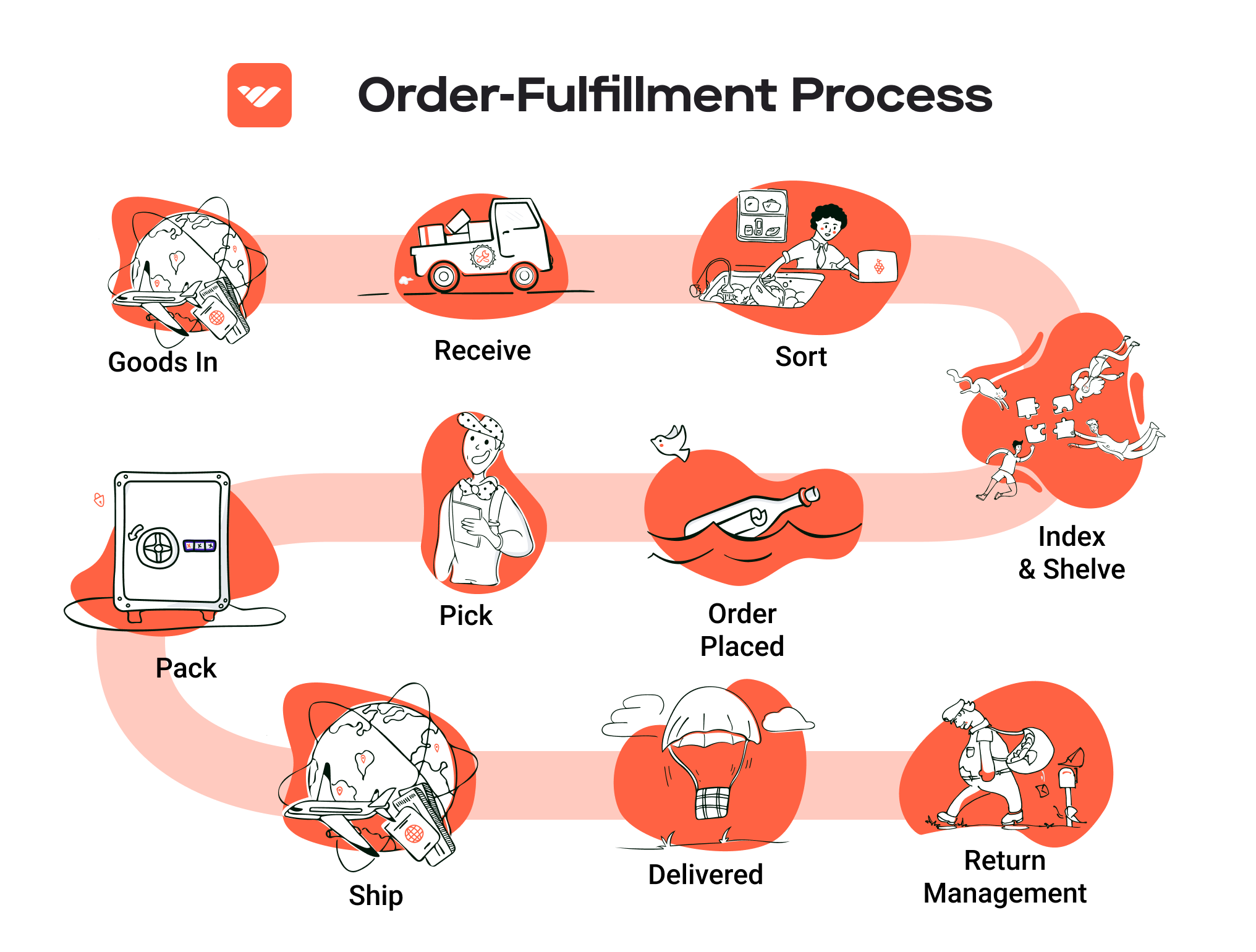
Importance: Proper packing is essential to prevent damage during shipping and to ensure that customers receive their orders as expected. Effective packing also helps minimize shipping costs by optimizing package size and weight.
Key Term: Packing Slip – A document included with the shipment that lists the items contained in the package, serving as a receipt for the customer.
5. Shipping & Delivery
The final step in the order fulfillment process is shipping and delivery. Once the orders are packed, they are labeled and sent out for delivery. This involves coordinating with shipping carriers to ensure timely and accurate delivery to customers. Many micro-fulfillment centers have partnerships with various logistics providers to optimize shipping routes and costs.
Importance: The shipping stage is the culmination of the fulfillment process and significantly influences customer satisfaction. Fast and reliable delivery can enhance the overall shopping experience and encourage repeat business.
Key Term: Last-Mile Delivery – The final step of the delivery process where the product is transported from a transportation hub to the end customer, often the most critical and costly part of the shipping process.
By understanding and optimizing each of these steps, e-commerce businesses can enhance their order fulfillment processes, improve customer satisfaction, and ultimately drive growth. Leveraging technology, such as those used in Walgreens’ micro-fulfillment centers, can significantly streamline these operations, making them more efficient and effective.
Comparing Fulfillment Models: In-House vs. 3PL vs. Dropshipping
Fulfillment Models Overview
In the rapidly evolving landscape of e-commerce, choosing the right fulfillment model is crucial for scalability and efficiency. Here, we compare three primary fulfillment models: In-House Fulfillment, Third-Party Logistics (3PL), and Dropshipping. Each model has distinct characteristics that cater to different business needs and stages.
| Model | Who Handles Inventory | Best For (Business Stage) | Key Advantage | Key Disadvantage |
|---|---|---|---|---|
| In-House Fulfillment | Business itself | Established businesses | Full control over inventory and operations | High overhead costs and resource-intensive |
| Third-Party Logistics (3PL) | 3PL provider | Growing businesses | Scalability and access to advanced logistics | Less control over inventory and potential service variability |
| Dropshipping | Supplier | Startups and small businesses | Low upfront investment and minimal risk | Lower profit margins and reliance on supplier quality |
In-House Fulfillment
In-House Fulfillment involves a business managing its own inventory and logistics operations. This model is best suited for established businesses that have sufficient resources and want full control over their inventory management and fulfillment processes. The key advantage of in-house fulfillment is the ability to oversee every aspect of operations, from inventory storage to order processing and shipping. This control can lead to improved customer service, as businesses can implement tailored processes and respond quickly to customer needs.
However, the primary disadvantage of in-house fulfillment is the significant overhead costs associated with maintaining a warehouse, hiring staff, and managing logistics. This can be resource-intensive, requiring a substantial investment in technology, infrastructure, and human resources. For businesses looking to scale rapidly, the capital and operational demands of in-house fulfillment may hinder growth potential.
Third-Party Logistics (3PL)
Third-Party Logistics (3PL) refers to outsourcing logistics operations to a specialized provider. This model is ideal for growing businesses that need to scale without the burden of managing logistics themselves. 3PL providers typically offer a range of services, including warehousing, inventory management, order fulfillment, and shipping. The key advantage of this model is its scalability; businesses can easily adjust their logistics needs based on sales fluctuations without incurring the fixed costs associated with in-house operations.
However, using a 3PL also comes with some disadvantages. While businesses gain access to advanced logistics capabilities, they relinquish some control over inventory and shipping processes. This can lead to variability in service quality, which may affect customer satisfaction. Additionally, businesses must ensure clear communication and alignment with their 3PL partner to avoid issues related to inventory accuracy and fulfillment timelines.
Dropshipping
Dropshipping is a fulfillment model where businesses sell products without holding any inventory. Instead, when a customer places an order, the business purchases the item from a third-party supplier, who then ships it directly to the customer. This model is particularly well-suited for startups and small businesses due to its low upfront investment and minimal risk. Entrepreneurs can enter the market without the burden of managing inventory or the costs associated with warehousing.
The main advantage of dropshipping is the ability to offer a wide range of products without the financial commitment of purchasing inventory upfront. This allows businesses to test various products and markets with less risk. However, dropshipping also has significant disadvantages. Profit margins can be lower compared to other fulfillment models, as suppliers typically charge higher wholesale prices. Additionally, businesses are reliant on suppliers for inventory quality and shipping speed, which can impact customer satisfaction if not managed carefully.
Conclusion
Choosing the right fulfillment model depends on a business’s size, growth stage, and resource availability. In-house fulfillment offers control but requires significant investment, making it suitable for established companies. 3PL provides scalability and expertise, ideal for growing businesses looking to optimize their logistics. Dropshipping allows for minimal risk and investment, catering to startups and entrepreneurs testing the market. Understanding these models will empower e-commerce businesses to make informed decisions that align with their strategic goals and operational capabilities.
A Deep Dive into Amazon FBA: Pros, Cons, and Who It’s For
Understanding Fulfillment by Amazon (FBA)
Fulfillment by Amazon (FBA) is a service provided by Amazon that allows businesses and sellers to store their products in Amazon’s fulfillment centers. Amazon takes care of storage, packaging, and shipping of these products directly to customers. This service is particularly beneficial for e-commerce businesses looking to scale operations without the headache of managing logistics.
How FBA Works
-
Setup: Sellers create an Amazon seller account and register for FBA. They list their products and prepare them for shipment to Amazon’s fulfillment centers.
-
Inventory Management: Once products are shipped to Amazon, the seller’s inventory is stored in one or more of Amazon’s warehouses. Sellers can track their inventory through the Amazon Seller Central dashboard.
-
Order Processing: When a customer orders a product, Amazon handles the entire process. This includes picking the product from the warehouse, packing it, and shipping it directly to the customer.
-
Customer Service: Amazon also provides customer service for FBA orders, including handling returns and refunds, allowing sellers to focus on other aspects of their business.
-
Payment: After the sale, Amazon deducts its fees from the sale price and transfers the remaining balance to the seller’s account.
Pros of Using FBA
Prime Eligibility
One of the most significant advantages of using FBA is that products become eligible for Amazon Prime. This means they can be shipped to Prime members with free two-day shipping, which can significantly increase sales and customer trust.
Customer Trust
By using FBA, sellers benefit from Amazon’s trusted brand. Customers are more likely to purchase items that are fulfilled by Amazon due to the perceived reliability and quality of service. This trust can lead to higher conversion rates and repeat purchases.
Multi-Channel Fulfillment
FBA is not limited to sales on Amazon alone. Sellers can use FBA for orders from their own websites or other e-commerce platforms, allowing for a streamlined fulfillment process across multiple channels.
Simplified Logistics
FBA simplifies the logistics of inventory management, shipping, and customer service. This allows sellers to focus on marketing and product development rather than getting bogged down in operational details.
Scalability
FBA provides a scalable solution for growing businesses. As demand increases, sellers can easily send more inventory to Amazon without having to invest in additional warehousing or fulfillment capabilities.
Cons of Using FBA
High Fees
One of the primary downsides of FBA is the cost. Amazon charges various fees, including storage fees, fulfillment fees, and additional charges for long-term storage of unsold inventory. These fees can eat into profit margins, especially for lower-priced items.
Strict Inventory Rules
Sellers must adhere to Amazon’s strict inventory guidelines. This includes how products are packaged, labeled, and stored. Any deviation can result in additional fees or penalties, making it essential for sellers to understand and comply with these rules.
Commingling Risks
When using FBA, sellers’ products may be commingled with inventory from other sellers. This can lead to issues if a customer receives a product that does not meet their expectations or if there are quality control problems. Sellers may also face challenges in identifying their inventory, which can complicate returns and refunds.
Limited Control Over Fulfillment
While FBA simplifies logistics, it also means that sellers have less control over the fulfillment process. If there are issues with shipping or customer service, sellers may find it challenging to rectify the situation quickly, as they must rely on Amazon’s processes.
Inventory Management Challenges
While Amazon’s infrastructure is robust, managing inventory levels can be challenging. Sellers must balance between having enough stock to meet demand and avoiding high storage fees for excess inventory.
Who is FBA Best For?
Fulfillment by Amazon is particularly beneficial for:
-
Small to Medium-Sized Businesses: Businesses looking to scale without the overhead of managing their own logistics will find FBA an attractive option.
-
E-commerce Entrepreneurs: Those starting an online store can leverage FBA to tap into Amazon’s vast customer base and infrastructure without significant upfront investment.
-
Brands with High Demand Products: Sellers with products that are consistently in demand can benefit from the efficiencies of FBA, maximizing their sales potential.
-
Sellers Seeking Convenience: If a seller prefers to focus on marketing, product development, or customer engagement rather than logistics and fulfillment, FBA provides a hassle-free solution.
-
Multi-Channel Sellers: Businesses selling on multiple platforms can use FBA for all their fulfillment needs, providing a streamlined and consistent customer experience.
In conclusion, while FBA offers numerous benefits that can help scale an e-commerce business effectively, it also comes with its set of challenges. Understanding the pros and cons is crucial for business owners and operations managers to make informed decisions about whether FBA is the right fit for their logistics strategy.
Core Services Offered by Fulfillment Centers
Inventory Management & Warehousing
Inventory management and warehousing are foundational services offered by fulfillment centers that ensure efficient stock control and optimal space utilization. Fulfillment centers utilize advanced inventory management systems to track stock levels, manage reorders, and monitor product movement in real-time. This technology enables businesses to maintain accurate inventory counts, reduce the risk of stockouts or overstock situations, and facilitate timely order fulfillment.
For e-commerce businesses, effective inventory management leads to improved operational efficiency. By outsourcing warehousing to a fulfillment center, businesses can minimize the costs associated with maintaining their own storage facilities, such as rent, utilities, and staffing. Moreover, fulfillment centers often have the capability to scale inventory based on seasonal demand fluctuations, allowing businesses to respond swiftly to market changes without incurring significant overhead costs.
Additionally, fulfillment centers typically offer climate-controlled storage solutions for sensitive products, ensuring the integrity of items such as pharmaceuticals or perishable goods. This specialized warehousing service can enhance product quality and customer satisfaction, ultimately contributing to repeat business and brand loyalty.
Pick and Pack Services
Pick and pack services are critical components of fulfillment operations, involving the selection (picking) of products from inventory and the preparation (packing) of those products for shipment. Fulfillment centers employ efficient picking strategies, such as batch picking or zone picking, to streamline the order fulfillment process. These methods reduce the time it takes to gather items for shipment, enhancing overall operational efficiency.
The benefits of pick and pack services for e-commerce businesses are manifold. Firstly, they ensure that orders are processed quickly, which is vital for customer satisfaction in today’s fast-paced market. By outsourcing this function to a fulfillment center, businesses can leverage the center’s expertise and technology, which may be more advanced than their own. This can lead to fewer errors in order fulfillment, reducing the likelihood of returns and enhancing customer trust.
Moreover, fulfillment centers often offer custom packing options, allowing businesses to create a unique unboxing experience that can enhance brand perception. This can include branded packaging, inclusion of promotional materials, or specialized packing for fragile items. Such personalized touches can increase customer engagement and drive repeat purchases.
Kitting and Assembly
Kitting and assembly services involve the grouping of multiple products into a single kit or the assembly of components into a finished product. Fulfillment centers are equipped to handle complex kitting tasks, such as bundling products for promotional offers or assembling items that require multiple parts. This service is particularly beneficial for e-commerce businesses that sell products needing assembly or those that wish to offer curated bundles to enhance customer experience.
The primary advantage of kitting and assembly services is the ability to streamline the production and fulfillment process. By outsourcing these tasks, businesses can reduce lead times and eliminate the need for in-house assembly operations, freeing up valuable resources and labor. This efficiency can significantly enhance the speed of bringing products to market, especially for seasonal promotions or new product launches.
Additionally, kitting can improve inventory management by consolidating various products into a single SKU, simplifying stock management and reducing the complexity of inventory tracking. This can lead to more accurate forecasting and better alignment with customer demand, ultimately resulting in improved sales performance.
Returns Management (Reverse Logistics)
Returns management, also known as reverse logistics, is a crucial service offered by fulfillment centers that focuses on the efficient handling of returned products. This process encompasses the return of goods from customers back to the fulfillment center, assessment of the returned items, and reintegration into inventory or disposal if necessary. Effective returns management is vital for maintaining customer satisfaction and loyalty, as it directly impacts the customer’s post-purchase experience.
For e-commerce businesses, a streamlined returns process can differentiate them from competitors. Fulfillment centers often provide easy return label generation, tracking of returned items, and timely processing of refunds or exchanges. This efficiency not only enhances the customer experience but also reduces the administrative burden on the business, allowing them to focus on growth and sales.
Furthermore, effective returns management helps businesses analyze return patterns, providing valuable insights into product quality and customer preferences. By understanding why products are returned, businesses can make informed decisions regarding inventory, product design, and marketing strategies. This data-driven approach can lead to improved product offerings and increased customer satisfaction, ultimately driving higher sales and profitability.
In conclusion, the core services offered by fulfillment centers—inventory management and warehousing, pick and pack services, kitting and assembly, and returns management—are essential for e-commerce businesses aiming to scale operations effectively. By leveraging these services, businesses can enhance operational efficiency, improve customer satisfaction, and ultimately drive growth in a competitive marketplace.
How to Choose a Fulfillment Partner: A 6-Point Checklist
Location & Warehouse Network
Importance:
The geographical location of a fulfillment partner’s warehouses can significantly impact shipping times, costs, and overall service quality. A partner with strategically placed facilities can help reduce transit times and shipping expenses, especially for businesses aiming to offer quick delivery options.
Questions to Ask:
– Where are your warehouses located, and how do those locations align with our customer base?
– How many warehouses do you operate, and do you have plans for expansion in other regions?
– Can you provide insights into your average shipping times and costs based on different regions?
Technology & Integrations
Importance:
A fulfillment partner’s technology stack is crucial for seamless operations. Efficient inventory management, order processing, and tracking capabilities can streamline your logistics and improve customer satisfaction. Additionally, the ability to integrate with your existing e-commerce platforms is essential for maintaining operational efficiency.
Questions to Ask:
– What technology do you use for inventory management and order processing?
– Are your systems compatible with major e-commerce platforms (e.g., Shopify, Magento, WooCommerce)?
– Can you provide real-time tracking capabilities for orders, and how is this information shared with customers?
Specializations (e.g., Cold Storage, Oversized Items)
Importance:
Different products require different handling and storage conditions. If your business deals with perishable goods, hazardous materials, or oversized items, it’s essential to partner with a 3PL that specializes in those areas. This ensures compliance with regulations and maintains the integrity of your products.
Questions to Ask:
– Do you have specialized facilities for handling specific product types, such as cold storage for perishables or space for oversized items?
– What safety and compliance measures do you have in place for handling sensitive products?
– Can you share examples of how you’ve successfully managed logistics for businesses in our industry?
Scalability & Capacity
Importance:
As your business grows, your fulfillment needs will change. A partner should not only handle your current volume but also scale up operations to accommodate future growth. Assessing their capacity to manage fluctuations in demand is crucial for maintaining service levels during peak seasons.
Questions to Ask:
– What is your current capacity for handling orders, and how do you manage peak seasons?
– Can you provide examples of how you’ve scaled operations for other clients?
– What contingency plans do you have in place for unexpected spikes in order volume?
Pricing and Contracts
Importance:
Understanding the pricing structure is vital to ensure that the partnership is cost-effective. Transparency in pricing helps avoid unexpected costs down the line, which can impact your profit margins. Additionally, evaluating the terms of the contract can prevent misunderstandings.
Questions to Ask:
– Can you provide a detailed breakdown of your pricing structure, including any hidden fees?
– What are the terms of your contracts, and is there flexibility for renegotiation based on performance?
– How do you handle costs related to returns, damaged goods, or order cancellations?
Customer Support & Reviews
Importance:
Reliable customer support is a key aspect of any partnership. A 3PL that provides excellent customer service can help resolve issues quickly, minimizing disruptions to your operations. Additionally, researching reviews and testimonials can provide insight into their reputation and reliability.
Questions to Ask:
– What level of customer support do you offer, and how can we reach you in case of urgent issues?
– Can you share case studies or testimonials from current or past clients?
– How do you handle customer service inquiries, and what is your average response time?
Conclusion
Choosing the right fulfillment partner is a critical decision that can significantly influence your e-commerce success. By assessing potential partners against this checklist, you can ensure that you select a 3PL that aligns with your business needs and growth ambitions. Take the time to conduct thorough due diligence, ask the right questions, and establish a partnership that will support your operational goals effectively.
Understanding Fulfillment Pricing: A Breakdown of Common Fees
Initial Setup Fees
Initial setup fees are typically incurred when you first engage a fulfillment center. These fees can cover a variety of services, including account setup, integration with your existing e-commerce platforms, and initial inventory processing. The cost can vary widely depending on the complexity of your operations and the specific services offered by the fulfillment provider.
To calculate these fees, consider factors such as:
– Integration Complexity: If your e-commerce system requires custom API integrations, expect higher fees.
– Inventory Onboarding: The number of SKUs and the volume of inventory you plan to send to the fulfillment center can also influence the initial costs. More extensive inventories may require additional handling and processing time.
– Training Costs: Some providers may charge for training your staff to use their systems effectively.
Receiving Fees
Receiving fees are charged for the process of accepting and logging your products into the fulfillment center’s inventory system. This fee can be a flat rate or charged per pallet or SKU received, depending on the fulfillment provider’s pricing model.
When calculating receiving fees, consider:
– Volume of Shipments: Larger shipments might incur lower per-unit costs due to economies of scale.
– Condition of Goods: Products that require inspection or special handling may incur additional fees.
– Complexity of Inventory: If your items require specific storage conditions (e.g., refrigerated items), this can also affect the receiving fee.
Storage Fees (per pallet/bin)
Storage fees are charged for the space your inventory occupies within the fulfillment center. This fee is typically calculated on a per-pallet or per-bin basis and is charged monthly.
To assess storage fees, keep in mind:
– Volume of Inventory: The more space your inventory requires, the higher your storage fees will be.
– Seasonal Variations: If your business experiences seasonal spikes in inventory (like holiday seasons), be aware that storage costs can increase during peak times.
– Long-Term Storage: Some fulfillment centers may impose additional fees for inventory that remains in storage for an extended period, encouraging businesses to manage their stock efficiently.
Pick & Pack Fees (per item/order)
Pick and pack fees are charged for the labor involved in selecting items from storage and packaging them for shipment. These fees can be structured per item or per order, with some providers offering tiered pricing based on volume.
When evaluating pick and pack fees, consider the following:
– Number of Items per Order: Larger orders typically incur higher fees due to the additional picking time required.
– Special Packaging Requirements: If your products require custom packaging or handling (like fragile items), this can increase costs.
– Volume Discounts: Many fulfillment centers offer discounts for higher volumes of orders, so consider your average order size when negotiating fees.
Shipping Fees
Shipping fees cover the cost of transporting your products from the fulfillment center to your customers. These fees can vary significantly based on the shipping method selected, the destination, and the weight and dimensions of the package.
Key factors to consider when calculating shipping fees include:
– Carrier Rates: Different carriers (e.g., FedEx, UPS, USPS) have varying rates, so it can be beneficial to compare costs.
– Shipping Zones: The distance from the fulfillment center to the delivery address will influence shipping costs; longer distances typically incur higher fees.
– Service Level: Expedited shipping options will cost more than standard ground shipping, so consider your customers’ expectations and your pricing strategy.
Tips for Getting an Accurate Quote
-
Provide Detailed Information: When requesting a quote, supply comprehensive information about your product dimensions, weights, and expected order volumes. This allows fulfillment centers to provide a more accurate estimate.
-
Inquire About All Fees: Ensure you understand all potential fees, including any hidden or additional costs associated with specific services.
-
Compare Multiple Providers: Don’t settle for the first quote you receive. Compare pricing and services from multiple fulfillment centers to find the best fit for your business needs.
-
Ask for Volume Discounts: If you anticipate significant order volumes, inquire about bulk pricing or long-term contracts that could reduce overall costs.
-
Review Contract Terms: Pay attention to the fine print in contracts regarding fee structures, minimum commitments, and conditions for price changes.
By understanding these common fulfillment pricing models and taking proactive steps to get accurate quotes, you can better manage your logistics costs and ensure your business scales effectively.
Frequently Asked Questions (FAQs) about Fulfillment
1. What is a Walgreens Micro-Fulfillment Center (MFC)?
A Walgreens Micro-Fulfillment Center (MFC) is an automated facility designed to efficiently dispense and ship prescriptions directly to Walgreens retail locations. Utilizing advanced robotic technology, these centers enhance the speed and accuracy of order fulfillment, allowing pharmacists to dedicate more time to patient care.
2. How does a micro-fulfillment center differ from a traditional warehouse?
Micro-fulfillment centers focus on speed and efficiency in order processing, particularly for pharmaceuticals. Unlike traditional warehouses, which may handle larger inventories and various product categories, MFCs are specialized for quick turnaround of prescription orders. They often employ automation and robotics to streamline operations and reduce labor costs.
3. What are the benefits of using a Walgreens Micro-Fulfillment Center?
The primary benefits include increased efficiency in prescription processing, improved accuracy in order fulfillment, enhanced patient care through reduced pharmacist workload, and quicker delivery times to retail stores. MFCs also contribute to sustainability efforts by incorporating recycling programs.
4. How many Walgreens Micro-Fulfillment Centers are currently in operation?
As of May 2025, Walgreens operates 12 micro-fulfillment centers across the United States, supporting nearly 200 retail locations in the Midwest alone. This network processes approximately 3.5 million prescriptions weekly.
5. What types of jobs are available at a Walgreens Micro-Fulfillment Center?
Positions typically include pharmacy technicians, fulfillment specialists, function leads, and maintenance technicians. These roles focus on various aspects of the fulfillment process, from order processing to equipment maintenance, ensuring smooth operations within the MFC.
6. How much do fulfillment services cost?
The cost of fulfillment services can vary widely depending on factors such as order volume, service level agreements, and specific operational requirements. Generally, businesses should expect to pay for storage, picking and packing, shipping, and any additional services like inventory management or returns processing. For a precise estimate, it’s advisable to consult with a fulfillment service provider.
7. What is a Third-Party Logistics Provider (3PL)?
A Third-Party Logistics Provider (3PL) is a company that offers outsourced logistics services, including transportation, warehousing, and distribution. Businesses often partner with 3PLs to manage their supply chain more effectively, allowing them to focus on core business activities while leveraging the expertise and resources of the 3PL.
8. How does Walgreens ensure accuracy in order fulfillment at its MFCs?
Walgreens employs advanced robotics and automated systems within its micro-fulfillment centers to minimize human error. These technologies allow for precise picking and packing of prescriptions, along with regular audits and quality control measures to ensure the integrity of the fulfillment process.
9. Can Walgreens Micro-Fulfillment Centers handle non-prescription items?
While Walgreens MFCs are primarily designed for the efficient processing of prescription medications, they may also be configured to manage certain non-prescription items. However, the core focus remains on pharmaceuticals and healthcare products to meet the specific needs of patients and pharmacies.
10. What impact do micro-fulfillment centers have on community health services?
Micro-fulfillment centers significantly improve the ability of pharmacists to provide community health services by reducing the time spent on filling prescriptions. This allows pharmacists to engage more with patients, offering services such as medication counseling, immunizations, and health screenings, thereby enhancing overall community health outcomes.
Conclusion: Is Outsourcing Fulfillment the Right Move for Your Business?
Assessing the Benefits of Outsourcing Fulfillment
Outsourcing fulfillment can be a transformative decision for e-commerce businesses, particularly for those looking to scale operations efficiently. By leveraging a fulfillment service, businesses can save valuable time, allowing teams to focus on core activities such as marketing and customer engagement rather than the intricacies of inventory management and shipping logistics. This shift not only enhances productivity but also improves overall operational efficiency.
Scalability is another significant advantage. As your business grows, a reliable fulfillment partner can seamlessly adjust to fluctuating order volumes without the need for substantial capital investment in infrastructure or labor. This flexibility is crucial in today’s fast-paced market, where consumer demands can change rapidly.
Moreover, partnering with experts in fulfillment means tapping into specialized knowledge and technology that can streamline processes. For example, companies like Walgreens have successfully implemented micro-fulfillment centers that utilize robotic technology to enhance efficiency and reduce errors in order processing. Such innovations can be challenging and costly to develop in-house, making outsourcing an attractive option.
Choosing the Right Partner for Growth
However, the success of outsourcing hinges on selecting the right fulfillment partner. Conduct thorough research, assess their technology, logistics capabilities, and customer service track record. The right partner will not only support your growth but also align with your business values and customer expectations.
Call to Action
Take a moment to audit your current shipping and fulfillment processes. Are they holding you back from achieving your growth potential? By evaluating your operations, you can determine if partnering with a fulfillment service is the strategic next step for your business. Embrace the opportunity to streamline your logistics and elevate your customer experience—your future growth may depend on it.
Important Disclaimer
⚠️ Important Disclaimer
The information in this guide is for educational purposes. Fulfillment services, pricing, and platform features change frequently. Always conduct your own due diligence and consult with providers directly before making business decisions.


